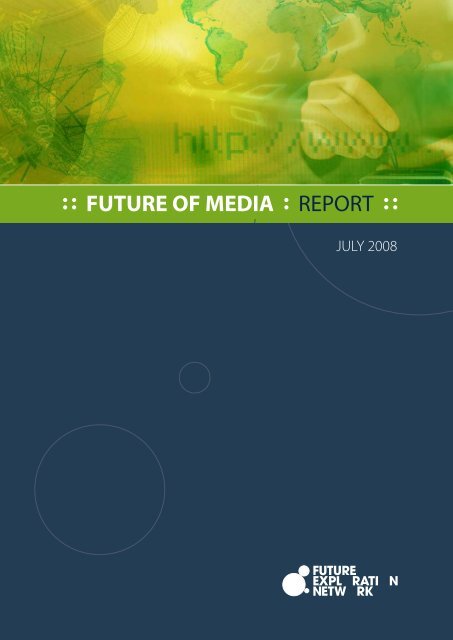Future of Media Report 2008 - Ross Dawson
Future of Media Report 2008 - Ross Dawson
Future of Media Report 2008 - Ross Dawson
- No tags were found...
Create successful ePaper yourself
Turn your PDF publications into a flip-book with our unique Google optimized e-Paper software.
: : FUTURE OF MEDIA : REPORT : :JULY <strong>2008</strong>
: : FUTURE OF MEDIA : REPORT : : JULY <strong>2008</strong>WELCOME: : FUTURE OF MEDIA <strong>2008</strong> : PARTNERS : :Strategic PartnersPartnersWe are entering the media economy. Thetraditional boundaries <strong>of</strong> the media andentertainment industry have becomemeaningless. Today almost everybusiness and social activity is a form<strong>of</strong> media. An increasing proportion <strong>of</strong>our social interactions happen acrossmedia channels. Every organization isnow a media entity, engaged in creatingand disseminating messages among itsstaff, customers, and partners to achievebusiness objectives. As the physical economybecomes marginalized and economic valuebecomes centered on the virtual, mediaencompasses almost everything.At the same time, many media organizations are experiencingsevere challenges, as content proliferates, audiences changebehaviors, advertising revenue erodes, and new competitorsemerge. Others are prospering as they tap swiftly growingsectors, leverage amateur content creation, tap the power <strong>of</strong>social networks, and scale production costs. Meanwhile adjacentindustries such as telecom, financial services, mobile phones,consumer electronics, pr<strong>of</strong>essional services, and even automobileare becoming media participants.Each year <strong>Future</strong> Exploration Network runs the <strong>Future</strong> <strong>of</strong> <strong>Media</strong>Summit, linking Silicon Valley and Sydney with video and crosscontinentaldiscussions, and launches an accompanying report.The striking impact <strong>of</strong> the 2006 and 2007 <strong>Future</strong> <strong>of</strong> <strong>Media</strong> <strong>Report</strong>smeans this year’s report has a lot to live up to. We are confidentthe new frameworks and ideas we are contributing will againprovide substantial value.Over the last years we have helped many media organizationsdevelop and implement effective strategies. We thrive on helpingcompanies to create the future <strong>of</strong> media. However it is alsoexciting to take these issues and conversations into a broadersphere. Welcome to the conversation.<strong>Ross</strong> <strong>Dawson</strong>Chairman<strong>Future</strong> Exploration NetworkPage 2
MEDIA: A GROWTH MARKETSIZE OF GLOBAL MEDIA ANDENTERTAINMENT MARKET IN <strong>2008</strong>:$US 1.7 trillionSource: PricewaterhouseCoopersSIZE OF GLOBAL MEDIA ANDENTERTAINMENT MARKET IN 2024:$US 5.7 trillion (<strong>2008</strong> dollars)Source: <strong>Future</strong> Exploration Network<strong>Media</strong>, entertainment, and related industries are positioned at the center <strong>of</strong> massive globalgrowth. The current positioning <strong>of</strong> some media companies in a rapidly changing marketmeans they are not experiencing this upside. Others are doing fabulously well in tappingpeople’s almost insatiable desire for content and connection. In this report we explore thegrowth and opportunities available to all participants in the vast landscape which is media.Fastest growing advertising markets 2007 - 2010Source: Zenith OptimediaGlobal advertising revenuesSource: Zenith OptimediaUS$ billion0 2 4 6 8 10 12 14 16 18 20600USAChinaRussiaBrazilUKIndiaJapanSouth KoreaSouth AfricaPhilippines0 10 20 30 40 50 60 70 80 90 100%US$ bn50040030020010002005 2006 2007 <strong>2008</strong> 2009 2010InternetCinemaOutdoorTelevisionRadioMagazinesNewspapersPage 3
Hours per weekmillion1009080706050403020100350300250200150100500<strong>Media</strong> ConsumptionSource: Carat1900 1920 1940 1960 1980 2000 20202FragmentationAt the same time as we are consuming moremedia, every existing media channel is beingfragmented, and new ones are being addedapace. In the example <strong>of</strong> television in this chart, we watch evermore television, but the proliferation <strong>of</strong> new channels meanscontinually less viewer time per channel. Now that the Internetand mobile are creating an explosion <strong>of</strong> new channels andcontent, audiences are being divided into smaller and smallersegments.Implications:Current mass media markets are ephemeral.Revenues per channel will decrease. In all excepta handful <strong>of</strong> cases, production costs will needto scaled down.User generated contentSource: Technorati, Flickr, Alexa, Comscore, www.internetworldstats.com2005 2006 2007 <strong>2008</strong>Flickr photos (x 0.1)Facebook visitorsNumber <strong>of</strong> blogsYouTube visitorsInternetDigital TVAnalogue TVGamesWirelessOutdoor <strong>Media</strong>Digital RadioAnalogue RadioCinemaPrint60504030201007 Driving Forces Shaping <strong>Media</strong>1Increasing <strong>Media</strong> ConsumptionIncreasing media consumption Humans areintrinsically media animals. As we get greater accessto media and content, we are discovering that ourappetite for information and entertainment is virtually insatiable.It is commonplace for people <strong>of</strong> all ages to consume multiplemedia at the same time, with television, internet, newspaper,messaging, and other media frequently overlapping.Implications:Average total media consumption will exceed wakinghours. Most media will be consumed with partial attention.Advertising impact will decrease.3ParticipationEarly talk about consumer-generated media has become astark reality over the last two years, with an explosion <strong>of</strong> mediaparticipation across blogs, photos, videos, social networks,and more. The costs <strong>of</strong> quality content creation are plummeting. Alreadya large proportion <strong>of</strong> content available is non-pr<strong>of</strong>essional, and people’smedia activities are increasingly focused on participatory channels such associal networks.Implications:An infinite supply <strong>of</strong> content. Increased fragmentation <strong>of</strong> attention.Pro-Am (pr<strong>of</strong>essional-amateur) content modelswill emerge.Exabytes(10 18 Bytes)Total IP bandwidthConsumerConsumer videoUS TV FragmentationSource: <strong>Media</strong> Dynamics and Bear Sterns1950 1960 1970 1980 1990 2000 200550454035302520151050YearGlobal IP trafficSource: Cisco2006 2007 <strong>2008</strong> 2009 2010 2011 201214121086420weeklyset usage (hrs)time perchannel (hrs)4Personalization<strong>Media</strong> is becoming personalized. Ultimately this isabout user control, in enabling every possible choice inwhat, when, and where people consume media, and itsformatting, filtering, and presentation. At the same time, real-timeinformation on viewers enables highly targeted advertising based onbehaviors, location, and other pr<strong>of</strong>ile data. The fate <strong>of</strong> personalizedadvertising will depend on how societal attitudes to privacy evolve.Implications:Users’ expectations for control over their media will increase.Abuse <strong>of</strong> personalized advertising will create a backlash. Somewill opt-out, and others will opt-in if sufficient value is created.Platform-AAdvertising.comYahoo! NetworkGoogle Ad NetworkSpecific <strong>Media</strong>ValueClick NetworksYahoo!Tribal FusionGoogleCasale <strong>Media</strong> NetworkDRIVEpmadconion media groupTraffic MarketplaceAOL <strong>Media</strong> NetworkinterCLICKMSN-Windows LiveTremor <strong>Media</strong>24/7 Real <strong>Media</strong>ADSDAQBurst <strong>Media</strong>US Internet audience reachSource: comScore, <strong>Media</strong> MetrixUS$millionAdvertising NetworksWeb Property0 10 20 30 40 50 60 70 80 90 100% <strong>of</strong> US online population6Generational changeThe chart shows that each generation is fairly consistentin its media consumption patterns, however that eachgroup behaves very differently. The average audience age<strong>of</strong> traditional media such as television and radio continues to increase.Over the medium to long-term, generational change will result indramatically different pr<strong>of</strong>iles for media consumption and participation.Implications:<strong>Media</strong> channels will be increasingly age-segmented. Advertiserswill accelerate their shift to new media outlets. Sharemarketvaluations will reflect age pr<strong>of</strong>iles <strong>of</strong> audiences.40003500300025002000150010005000Behavioral AdvertisingSource: eMarketer2005 2006 2007 <strong>2008</strong> 2009 2010 20115New revenue modelsWithin the current trend away from subscriptionand towards ad-supported business models, theway that advertising is sold is dramatically changing.As illustrated, the vast majority <strong>of</strong> the online players with thegreatest reach are advertising networks, not stand-alone sitessuch as Google or Yahoo! Unbundling sales and content isallowing far greater scalability <strong>of</strong> content production costs.The promise <strong>of</strong> micropayments for content may re-emergewithin a decade.Implications:Advertising aggregation will be central to the medialandscape. <strong>Media</strong> companies will segment andunbundle ad sales and content creation.80%70%60%50%40%30%20%10%0%Newspaper readership by ageSource: Journalism.org, Scarborough Research1999 2000 2001 2002 2003 2004 2005 200618 - 24 35 - 44 55 - 647Increasing bandwidth25 - 34 45 - 54 65+In developed countries the Internet has now shifted from dial-up to broadband in the home.A rapid pace <strong>of</strong> increase in bandwidth will continue indefinitely. It will not be too long before themajority <strong>of</strong> developed country homes receive over 100Mbps. At the same time mobile bandwidth issoaring, with a variety <strong>of</strong> technologies contributing to pervasive high-speed access to content.Implications:Video on demand anywhere, anytime. Personal clouds will allow music and video collections to be accessed anywhere without localstorage. The rationale for allocated media spectrum and infrastructure will fade.Strategy •Thought Leadership•Sponsored Content•For additional <strong>Future</strong> <strong>of</strong> <strong>Media</strong> Resourceswww.futureexploration.net
<strong>Future</strong> <strong>of</strong> the <strong>Media</strong> LifecycleHOME MOBILETIMESHIFTINGRECOMMENDATIONSSTORAGEPLACESHIFTINGPERSONAL CLOUDLIFESTREAMINGWORDSVIDEOPHOTOSRECORDERMUSIC SYSTEMDIGITAL VIDEOMEDIACENTERTVPCGAME CONSOLEVIDEO WALLPAPERFRAMESDIGITAL PICTUREINTERFACESFLAT SCREENSUNIVERSALREMOTERECOGNITIONGESTUREPRECIPITATIONOF PARTICIPATIONBROWSERCAMERAVIDEOHANDHELDMUSIC PLAYERPDAPHONEVIDEO GLASSESVOICERECOGNITIONeBOOK READERSNEWSPAPERSMAGAZINESPORTABLELAPTOPINTERFACESWIRELESSUPnPHOMENETWORKSPOWERLINEETHERNETCOAXSHOPPINGSIMULTANEOUSATTENTIONLONG- FORMIMMERSIVEGAMESHOME MEDIALIGHTINGINTELLIGENTDIFFUSIONOF MEMESDIFFUSIONOF MEMESALERTSMAPSTRAFFICLOCATIONBASED MEDIAOFFERSWEATHERKEYBOARDSWIRELESSPROJECTORMOBILELINK TOMOBILEVIDEOEVERYWHEREOUTDOORMEDIAINTERACTIVEBILLBOARDSPERSONALIZEDMESSAGESDIRECTIONSTIME-BASEDTV / VIDEOCONVERSATIONGAMESSEA OF CONTENTCOMMENTARYMUSICNEWSCreative Commons Attribution-Share Alike 3.0 LicenseCreated for:StrategyFor diagram explanation, Summit registration• Strategy• Thought LeadershipThought Leadership : : <strong>Future</strong> <strong>of</strong> <strong>Media</strong> : Summit <strong>2008</strong> : :For diagram explanation and other and additional <strong>Future</strong> <strong>of</strong> <strong>Future</strong> <strong>Media</strong> <strong>of</strong> <strong>Media</strong> Resources: resources:• Sponsored Sponsored Content ContentSilicon Valley July 14 | linked by video | Sydney July 15www.futureexploration.net/fom08
Finite players play within boundaries,infinite players play with boundaries.James CarseFlow Economy FrameworkThe Flow Economy Framework encompasses allactivity based on the flow <strong>of</strong> information and ideas.The diagram shows its six elements: Standards,Relationships, Connectivity, Interfaces,Content, and Services. All six elements arerequired to deliver value to customers.STANDARDSEach <strong>of</strong> these elements can be run as a standalonebusiness. However the greatest valueis unlocked in how they are combined. Only ahandful <strong>of</strong> companies have the capacity to play inall six elements <strong>of</strong> the flow economy, and even then theymust rely heavily on alliances. The heart <strong>of</strong> strategy in theflow economy is in leveraging existing strengths to moveinto a higher-value strategic position. As the landscapedevelops, this repositioning is a continuous process.More informationFull details on the Flow Economyframework and strategy process can befound in Chapter 7 <strong>of</strong> Living Networks.Free chapter download from:www.livingnetworksbook.comownershipFRAGMENTEDpeoplepowerwaiting forthe futureOPEN PROPRIETARYPLATFORMSplatformplaystitansclashCONCENTRATED<strong>Future</strong> <strong>of</strong> <strong>Media</strong>: Strategy ToolsScenario Planning for <strong>Media</strong>Classic scenario planning is one <strong>of</strong> the most powerful tools for rigorouslong-term strategy development in the media industry. In the face <strong>of</strong>multiple uncertainties, including technological development, consumerbehavior, standards battles, regulation, and many others, a well-designedscenario planning process assists the development <strong>of</strong> robust businessstrategies.Generic scenarios are <strong>of</strong> limited use. Scenarios need to be developedaround specific business issues and key decisions. A typical scenarioplanning process would include:•••••••••CONNECTIVITYCONTENTIn uncertain times, don’t try to predict thefuture. Systematically explore possible futures.Define objectives and key strategic decisionsIdentify driving forces and critical uncertaintiesSelect key dimensions<strong>Ross</strong> <strong>Dawson</strong>Create scenario frameworkDevelop distinct, plausible, complementary scenariosTest existing strategies across scenariosGenerate new strategic optionsINTERFACESSERVICESDefine a core strategy and contingent responsesBuild strategic responsiveness across the organizationRELATIONSHIPS3 Examples: Strategic repositioningin the Flow Economy1AppleApple has proved very effective atrepositioning itself across the floweconomy. Most prominently, it has usedits strong positioning in Interfaces (e.g. iPod, Mac)to shift to Content (iTunes). It has also built directRelationships with its iTunes customers whereasbefore distributors held all customer relationships.Apple’s adoption AAC as the default music encodingStandard on iTunes provided some lock-in as it was aless common though still open standard. For iPhoneit has selected and generated revenue from selectedpartners for Connectivity (AT&T in the US), and isnow taking part <strong>of</strong> the Service revenue for iPhoneapps provided by a broader developer community.2British Sky Broadcasting (BSkyB)BSkyB began with part ownership <strong>of</strong> the satellitesproviding the Connectivity for TV delivery,creating and buying Content, and using theseto create customer Relationships. In the early 1990s itsold its satellite ownership and since then has used theAstra satellites to provide the necessary Connectivity. Itsexclusive live TV Content rights for the FA Premier Leaguesince 1992 has been leveraged into strong subscriber growthand many new Relationships. In 2001 BSkyB introducedSky+, a combination set-top box and digital video recorder,providing an Interface to generate greater revenue andbuild more entrenched Relationships. BSkyB is now shiftinginto new Services including broadband and phone. It is alsodistributing its Content over new channels including mobileusing Sky Anytime.You have to learn the rules <strong>of</strong> thegame. And then you have to playbetter than anyone else.Albert EinsteinGame Theory: Strategies for Openness1.Flow Economy Strategy Process - SummaryDefine your spaceThe inexorable shift to openness dominates the media strategic landscape today. Allsuccessful platforms provide rich programming interfaces, open standards are swiftlybeing adopted, data portability is gaining momentum, most content is available on RSSfeeds, and controls on intellectual property are being loosened.The extraordinary pace <strong>of</strong> these trends means that media strategy is becoming morechallenging. New business models are required, competitive responses must be swift, andstrategic choices need to be made and implemented in real-time.In this environment game theory is extremely relevant and a valuable strategic tool.Game theory studies how multi-player situations may evolve as participants respond toeach others’ actions. This can be done using mathematical modelling, or more simply as aframework for thinking through strategic options, their impact on the industry landscape,and optimal short and long-term strategies.• What is the “total customer experience” you participate in creating?• Which elements <strong>of</strong> the flow economy do you currently providewithin this?• Who provides the other flow economy elements required?• What is your current relationship with these providers?2. Redefine your space• What is driving change in the flow <strong>of</strong> information and value in the space?• How can you redefine the total customer experience?• What are competitive drivers within each <strong>of</strong> the flow elements required?• How can you leverage your existing positioning into new sources <strong>of</strong>revenue or value?3.Reposition• Build internal capabilities.• Acquire existing businesses.• License content or technology.• Build alliances with complementary firms.• Outsource business activities.3NTT DoCoMoThe flow economy framework is especially relevantto telecoms providers that need to reposition fromcommoditized Connectivity into higher valuespaces. DoCoMo has distinguished itself by developingStandards including W-CDMA and i-mode, providing it withlocal market differentiation and access to international markets.Its alliances with phone manufacturers allow it to control theInterfaces used by its customers, creating more embeddedRelationships. i-mode’s staggering success after its 1999launch was largely attributable to its model <strong>of</strong> allowingthird-party Content and Services providers access to thesystem, with just a low margin for DoCoMo. DoCoMo is nowproviding financial Services through its DCMX mobilecredit cards, and, as other mobile companies, seekingto leverage its existing customer Interfaces toprovide search functionality.Strategy •Thought Leadership•Sponsored Content•For additional <strong>Future</strong> <strong>of</strong> <strong>Media</strong> Resourceswww.futureexploration.netSTRATEGYMAPCOMPETITORACOMPETITORBCOMPETITORCSTRATEGY1STRATEGY2STRATEGY3
: : FUTURE OF MEDIA : REPORT : : JULY <strong>2008</strong>SNIPPETSMEDIA SNIPPETSMore than 57% <strong>of</strong>online video viewersshare links to the videosthey find with othersPewUS newspapercirculation is the sameas in 1978, when therewere 100 million fewerpeople in AmericaNewspaper Association<strong>of</strong> AmericaThere are 1.4million newbroadband usersin China everymonth.China MobileSix in ten (59%) arenot comfortablewhen websites usebehavioural informationto tailor advertisementsor content.HarrisIn 2007 YouTubeconsumed as muchbandwidth as theentire Internetin 2000.Daily TelegraphRoughly one-fifth<strong>of</strong> all U.S. households aredisconnected from theInternet and have neverused e-mail.Parks AssociatesFrance has thelargest number <strong>of</strong> IPTVsubscribers in the world, withthree <strong>of</strong> the world’s four largestIPTV service providers (Free,Orange France Telecom and NeufCegetel). The remaining serviceprovider out <strong>of</strong> the top four isPCCW in Hong Kong.dailyIPTVThe median age <strong>of</strong>a US live televisionviewer is 50, comparedto 38 for the entirepopulation.Magna GlobalThirty seven percent<strong>of</strong> consumers saythey would rather payfor online contentthan be exposed toadvertisementsDeloitteAlmost 70% <strong>of</strong>journalists read blogsregularly, while 20% saythey spend over one hourper day reading blogsMarketwatchPage 10
ABOUT FUTURE EXPLORATION NETWORK<strong>Future</strong> Exploration Network assists major organizations globallyto gain insights into the future and develop strategies that createcompetitive advantage. Its unique services are delivered from itsdeep in-house expertise, complemented by its network <strong>of</strong> globalbest-<strong>of</strong>-breed experts.Clients <strong>of</strong> <strong>Future</strong> Exploration Network’s key executives includeABN Amro, Capgemini, CNET, Ernst & Young, IBM, KPMG, LendLease, Macquarie Bank, Micros<strong>of</strong>t, Morgan Stanley, NewsCorporation, and SAP.LEADERSHIP<strong>Ross</strong> <strong>Dawson</strong>Chairman<strong>Ross</strong> <strong>Dawson</strong> is a globally recognizedbusiness strategist and authority onthe future <strong>of</strong> technology and business,the best-selling author <strong>of</strong> LivingNetworks and Developing Knowledge-Based Client Relationships, and a frequentinternational keynote speaker. His work is regularly featured inleading print and broadcast media worldwide such as CNN,Bloomberg TV, Washington Post, Reuters, SkyNews, ABC TV, andChannel News Asia. <strong>Ross</strong> also writes the highly influential Trendsin the Living Networks blogVIRTUAL CONSULTING MODEL TAPS WORLD’S BEST<strong>Future</strong> Exploration Network has extensive in-house resources forconsulting, research, and content creation. We complement thesecore resources by drawing as required on our diverse network<strong>of</strong> global best-<strong>of</strong>-breed experts. This allows us to deliver unique,world-class services for projects <strong>of</strong> any scale.SERVICESStrategy consulting<strong>Future</strong> Exploration Network applies a range <strong>of</strong> tools andapproaches to assist its clients to develop clear, actionablestrategies in highly uncertain environments. We have deepexpertise in applying scenario planning to build robust strategies.ResearchDeep research into technological, social, and businesstrends supports clients’ strategic thinking, decisions, andimplementation. Technology landscapes help organizationsto plan long-term positioning, product development, andtechnology strategies.Thought leadership contentWe create content for leading organizations that will reachand engage attention-poor senior executives and support keymessages on technology and business trends. These can bedelivered in a wide variety <strong>of</strong> content formats, including print,presentations, documents, audio, video, and flash, and deliveredso they reach target audiences.Presentations and workshopsKeynote speeches and executive workshops can be deliveredby key <strong>Future</strong> Exploration Network executives <strong>Ross</strong> <strong>Dawson</strong>,Richard Watson, or other world-class presenters from our networkto stimulate, provoke, entertain, and provide input into specificstrategic decisions.EventsWe create focused, relevant, highly interactive conferencesand events that bring together the best minds in the field.FEN organizes both public events, and custom-designedevents for key sponsors.Go to www.futureexploration.net forother free publications including:<strong>Future</strong> <strong>of</strong> <strong>Media</strong> <strong>Report</strong> <strong>2008</strong> is published under aCreative Commons Attribution-ShareAlike 3.0 License<strong>Report</strong> Design: redk.com.au••••<strong>Future</strong> <strong>of</strong> <strong>Media</strong> <strong>Report</strong> 2006<strong>Future</strong> <strong>of</strong> <strong>Media</strong> <strong>Report</strong> 2007Web 2.0 FrameworkExecutive Insights into Enterprise 2.0Page 11
Contact Us<strong>Future</strong> Exploration NetworkSydney : : +612 9994 8011San Francisco : : +1(415) 315 9566London : : +44(0)20 8133 3638Email : : fen@futureexploration.netwww.futureexploration.net







